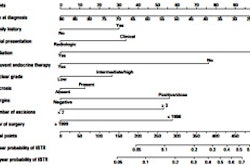In July, the U.S. Department of Health and Human Services (HHS) issued guidelines that require new private health plans to cover preventive services, including mammography screening for women 40 and older. Breast screening rates have taken a dip in recent months: Will the new rules boost them again?
Under the new regulations, health plans beginning on or after September 23 must cover preventive services that have strong scientific evidence of their health benefits. In addition, these plans may no longer charge a patient a co-payment, co-insurance, or deductible for these services when they are delivered by a network provider, according to HHS.
HHS' guidelines fly in the face of screening recommendations issued last November by the U.S. Preventive Services Task Force (USPSTF); in fact, HHS referred to the task force's 2002 recommendations on screening mammography for its new guidelines, rather than the ones from 2009, which indicated that women should begin screening mammography at 50 and have the exam biennially, rather than annually.
A 'huge relief'
The change is a huge relief for some breast imagers.
"I am thrilled to see that the Department of Health and Human Services is using the guidelines from the USPSTF's 2002 recommendations [for the age to begin screening]," said Stamatia Destounis, MD, from Elizabeth Wende Breast Care in Rochester, NY. "This sends a clear message to breast imagers and healthcare providers that the 2009 USPSTF recommendations aren't useful."
Yet even more than the age squabble, the overall economy has affected mammography screening rates as states slash funding for mammography screening programs. For many, the question is whether this new ban on co-pays will mitigate the situation.
It could help, according to Amal Trivedi, MD, assistant professor of community health and medicine at Brown University's Warren Alpert Medical School in Providence, RI. In a 2008 study published in the New England Journal of Medicine, Trivedi and colleagues found that co-pays of as little as $12.50 could deter 8% to 10% of women from getting timely screening mammograms (NEJM, January 2008, Vol. 358:4, pp. 375-383).
"Financial barriers can certainly cause women to opt out of screening mammography programs," Trivedi told AuntMinnie.com. "Eliminating co-payments and co-insurance would increase the likelihood that eligible populations would receive screening mammography."
But it's also understood that even if screening mammography is free, other barriers to access remain, Trivedi said. An important factor seems to be whether a woman's primary care physician personally recommends the mammogram to her, and geographic availability can also affect a woman's compliance.
And if more women get screened at the recommendation of their primary care physician, how physicians respond to the 2009 USPSTF's recommendations -- HHS guidelines or no -- will be important, according to Daniel Kopans, MD, professor of radiology at Harvard Medical School in Boston.
"[Patients] tend to follow what their doctors recommend," he told AuntMinnie.com in an e-mail. "The Annals of Internal Medicine polled the primary care doctors that read the journal [on use of the USPSTF 2009 guidelines], and 67% said they were going to follow them. So it remains to be seen what doctors will actually recommend for screening for their patients."
By Kate Madden Yee
AuntMinnie.com staff writer
August 10, 2010
Related Reading
HHS rules support earlier mammography, July 14, 2010
HHS proposes HIPAA changes, July 9, 2010
10,000-plus in U.S. die for lack of cancer screens: CDC, July 6, 2010
Follow-ups boost mammo use among insured low-income women, June 30, 2010
Mammography screening hard-hit by economic downturn, June 22, 2010
Copyright © 2010 AuntMinnie.com



















